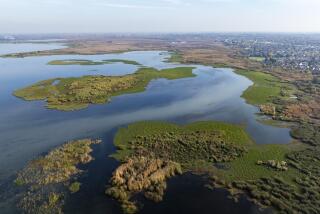California sea levels to rise 5-plus feet this century, study says
Sea levels along the California coast are expected to rise up to 1 foot in 20 years, 2 feet by 2050 and as much as 5 1/2 feet by the end of the century, climbing slightly more than the global average and increasing the risk of flooding and storm damage, a new study says.
That’s because much of California is sinking, extending the reach of a sea that is warming and expanding because of climate change, according to a report by a committee of scientists released Friday by the National Research Council.
In Washington and Oregon, where geological processes are flexing the land upward, researchers predict a less dramatic sea level rise that will register below the global average.
The report, commissioned by California, Oregon, Washington and several federal agencies, is the closest look yet at how global warming — which causes ocean water to expand and ice to melt — will raise sea levels along the West Coast.
Tide gauges show that the world’s oceans have risen about 7 inches in the last century, and that rate is accelerating, the report notes.
“Sea level rise isn’t a political question, it’s a scientific reality,” said Gary Griggs, director of the Institute of Marine Sciences at UC Santa Cruz and a member of the committee that produced the report.
Globally, the study predicts up to 9 inches of sea level rise by 2030, 1 1/2 feet by 2050 and 4 1/2 feet by 2100.
The projections are largely in line with other recent scientific estimates but substantially higher than the 2007 figures by the United Nations’ Intergovernmental Panel on Climate Change because they factor in a greater contribution from melting ice.
The study was drafted by a committee of scientists formed as a result of a 2008 executive order by Gov. Arnold Schwarzenegger, which directed state agencies to plan for the effects of sea level rise. The government agencies sponsored the study will use it to prepare for coastal erosion and flooding that is expected to threaten homes, businesses, roads, airports and other structures located within a few feet of the high-tide line.
The California Natural Resources Agency said in a statement that the report “confirms the need to take action to address the impacts of rising sea level.”
The study shows how unevenly the sea will rise from place to place because of regional factors such as the movement of tectonic plates, climate patterns such as El Niño and the effects of melting glaciers and ice sheets in Alaska, Greenland and Antarctica.
For instance, although tide gauges in California show sea levels rising over the last century, levels have been falling north of Cape Mendocino as geological activity pushes up the land. A major earthquake in the Pacific Northwest, such as a magnitude 8, could upend that trend, causing parts of the coast to sink and suddenly raising sea levels by 3 feet or more, the report says.
The report is the latest to warn that the rising sea will place coastal communities at increasing risk, with most of the damage caused by a combination of big waves, storm surges and high tides. The warm ocean conditions of a strong El Niño can magnify those effects, the report says, expanding sea water and raising sea levels by about a foot for several months.
Coastal California could see serious damage from storms within a few decades, especially in low-lying areas of Southern California and the Bay Area. San Francisco International Airport, for instance, could flood if the sea rises a little more than a foot, a mark expected to be reached in the next few decades. Erosion could cause coastal cliffs to retreat more than 100 feet by 2100, according to the report.
For an idea of what’s in store, the report says, look at what happened in the winter of 1983. That’s when a series of potent El Niño-driven storms hit California’s coast, causing more than $200 million in damage from flooding, high waves and erosion. More than 3,000 homes and businesses were damaged and 33 oceanfront homes destroyed.
Although the rise in sea levels will happen gradually, Griggs said, its destructive power will be felt first when storms hit vulnerable places such as Newport Beach and the San Francisco Bay.
“In the short term it’s these severe storms in low-lying areas that are most problematic,” Griggs said. “So we have to plan for that.”
More to Read
Start your day right
Sign up for Essential California for news, features and recommendations from the L.A. Times and beyond in your inbox six days a week.
You may occasionally receive promotional content from the Los Angeles Times.







